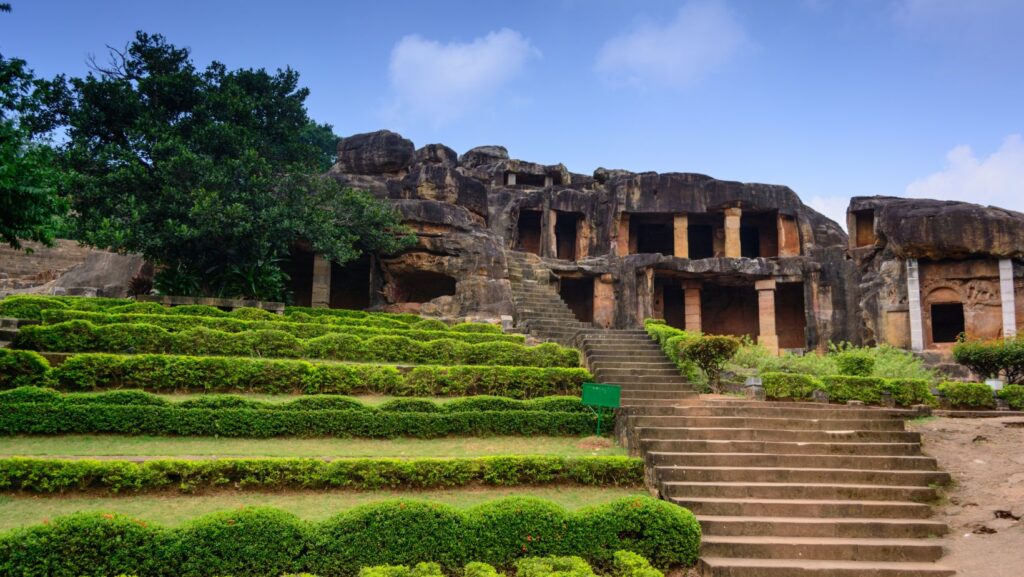Udayagiri and Khandagiri Caves stand as silent witnesses to the rich tapestry of history and spirituality that has unfolded over the centuries. For the avid history lover, udayagiri and khandagiri caves are not mere rock formations; they are portals to a bygone era, whispering tales of ancient empires, ascetic traditions, and architectural brilliance.

Here are some of the highlights of the caves that you should not miss:
• Hathi Gumpha: This is the largest and most famous cave in Udayagiri, which means “Elephant Cave” in Sanskrit. It has a huge arch-like entrance that resembles an elephant’s head. Inside the cave, there is a long inscription of 17 lines, written in Brahmi script, that narrates the exploits of King Kharavela, the most powerful ruler of the Kalinga dynasty. The inscription mentions his military campaigns, his patronage of arts and religion, his construction of public works, and his benevolence towards his subjects.
• Rani Gumpha: This is the largest and most ornate cave in Udayagiri, which means “Queen’s Cave” in Sanskrit. It is a double-storeyed cave with a spacious courtyard and a beautiful facade. The cave has elaborate carvings of scenes from Jain mythology, such as the life of Mahavira, the 24th and last Tirthankara (spiritual teacher) of Jainism, and the stories of the previous Tirthankaras. The cave also depicts scenes of royal life, such as hunting, dancing, music and courtship.
• Ananta Gumpha: This is one of the most interesting caves in Khandagiri, which means “Endless Cave” in Sanskrit. It has a series of cells with carved doorways, each with a different motif. The motifs include elephants, lions, bulls, monkeys, peacocks, geese, snakes and flowers. The cave is named after Ananta, the serpent king in Hindu mythology, who is also revered by Jains as a protector of their faith.
• Ganesha Gumpha: This is one of the most popular caves in Udayagiri, which means “Ganesha Cave” in Sanskrit. It is named after Ganesha, the elephant-headed god of wisdom and success in Hinduism, who is also worshipped by Jains as a remover of obstacles. The cave has a carving of Ganesha on the left wall of the entrance, along with his vehicle, the mouse. The cave also has carvings of other Hindu deities, such as Shiva, Parvati, Kartikeya, and Durga, indicating the syncretism of Jainism and Hinduism in ancient times.
These are just some of the amazing caves that you can explore at Udayagiri and Khandagiri. There are many more caves that have their own charm and significance, such as Jaya Vijaya Gumpha, Mancapuri Gumpha, Bagha Gumpha, and Sarpa Gumpha. You can also enjoy the panoramic view of the surrounding landscape from the top of the hills, and witness the sunrise and sunset from Udayagiri.
Udayagiri and Khandagiri Caves are a must-see destination for anyone who loves history, culture, and art. They are a testimony to the rich and glorious past of Odisha and a treasure trove of Jain heritage. visit the caves any time of the year, but the best time is between October and March when the weather is pleasant and the caves are less crowded. You can also combine your visit with other attractions in Bhubaneswar, such as the Lingaraj Temple, the Rajarani Temple, the Dhauli Shanti Stupa, and the Nandankanan Zoological Park.
So, what are you waiting for? Book your tickets and pack your bags for a memorable trip to Udayagiri and Khandagiri Caves, and discover the hidden gems of Odisha. You will not regret it!
